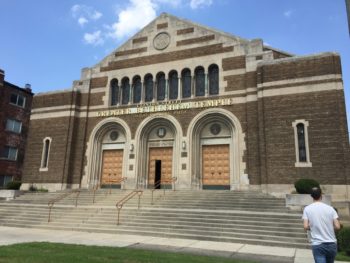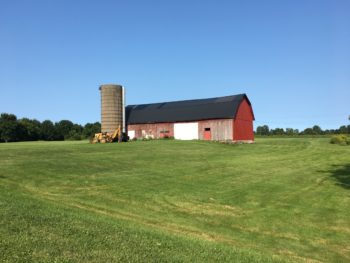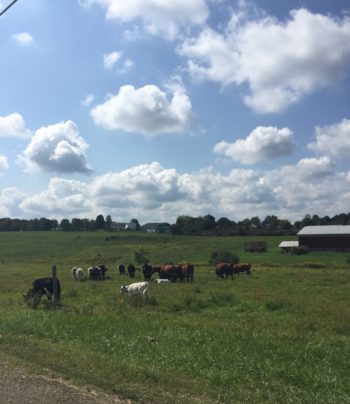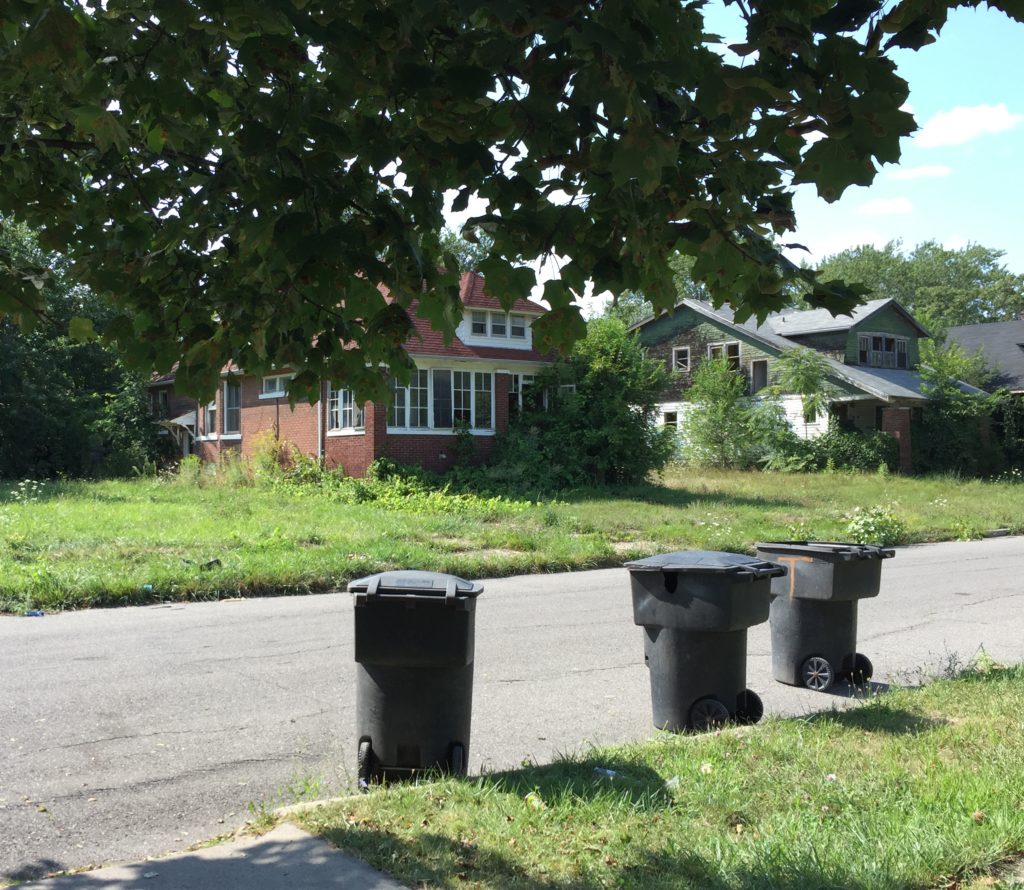Marge is locally renowned as a caregiver, a Johnny Appleseed of wisdom and practical knowledge in her aging and economically challenged rural community. She lives off a secondary road in Allegany County, NY sparsely traveled but for the oversized flatbeds loaded with fresh cut timber and a smattering of F150 pickups and their American-built cousins, many reaching vintage status.
This part of western NY is largely woodlands, increasingly so over the past two generations. A big portion of the county is designated as State Forest Reserve and much of the adjacent farmland is turning to bush. An attentive visitor can see material evidence of a rural economy that thrived, or at least persisted, though the 20th century and is now doing a disappearing act: teetering fence posts, falling-down barns, brackish scrub displacing long tended pasture.
Social and economic life in the region has also morphed, mirroring a pattern familiar across rural America over the past 3 decades. Large capital-intensive specialized operations dominate farm production. Only 1.3% of those working in the county are now employed in agriculture. The number of small and middle-sized family farms has sharply diminished along with a big chunk of small businesses that supported them. Majestic turn-of-the-century small town banks that speak to once muscular financial trade are now converted into cafes and book stores; feed supply stores are selling used furniture and “antiques;” churches and schools are firing on one cylinder, their populations aging out and unreplaced. Overall, the population of Allegany County has declined by 9% since 1979; 18.4% of folks live below the poverty line, compared with 13.3% in 1990.
This saga of social transformation tracks closely with Marge’s life course. Marge was one of seven children raised in a small rural town where her dad was mayor. But by the time she was out high school, she, her dad and her younger brother were the only family left in town. In what was surely an unanticipated development, she fell into one of the few growth industries in rural NY. At age 22, in nursing school with a young daughter and another child on the way, her grandmother fell ill with a rare lung disease. She and her dad stepped in, taking turns sleeping on her grandma’s couch to care for her.
Her grandmother lived for 2 years, far beyond her doctors’ expectations, a credit, they acknowledged, to the good care she was getting at home. She died in her matrimonial bed. As Marge sees it, such a death, and the care that made it possible, was a gift, a way of “giving back” and, as she looks back at those raw times, something special, “an honor.” Certainly some 40 years ago it was a rare social achievement. Today, even with the growth and popularity of hospice, only 20% of Americans die at home.
We met Marge as part of a study on family caregivers undertaken for the Ralph C Wilson, Jr. Foundation, a Detroit-based philanthropic with a singular focus on targeted social change and policy innovation in southeast Michigan and western New York.
 We visited households in all 16 counties of the foundation’s catchment area, from starkly rural Allegany County to starkly urban Buffalo and Detroit.
We visited households in all 16 counties of the foundation’s catchment area, from starkly rural Allegany County to starkly urban Buffalo and Detroit.  As anthropologists we set our sights on the shared understandings of family, kinship, gender, class, personhood, neighborhood, and place that informed how people went about caregiving and bent their commitments and actions this way or that.
As anthropologists we set our sights on the shared understandings of family, kinship, gender, class, personhood, neighborhood, and place that informed how people went about caregiving and bent their commitments and actions this way or that.
The Changing Landscape of Caring
 Radical structural change — the economic, demographic and geographic shifts that gained momentum in the 1990s and continued through the great recession — seems to have left an indelible if not permanent imprint on certain places in this country. This was clearly the case in many of the communities we visited–families dispersed, urban neighborhoods and rural communities hollowed out, social institutions of all sorts faltering. These disheartening facts on the ground have severely affected family caregivers. Accompanying this near collapse of the social scaffolding that supports the work and commitments of family caregiving we could see a brewing crisis of meaning, most immediately evident in the commonly voiced nostalgia for a world that still looks a bit familiar in the rearview mirror but is irrevocably lost. In this world, or more accurately worlds, people pitched in and watched out for each other. At least this is how things are remembered. If the past is a foreign country, so too are the working-class black neighborhoods of 1980s Detroit, the east side of Rochester when Kodak was colloquially known as the “great yellow mother”, and countless small farms where the kids milked the cows before heading to school in the morning.
Radical structural change — the economic, demographic and geographic shifts that gained momentum in the 1990s and continued through the great recession — seems to have left an indelible if not permanent imprint on certain places in this country. This was clearly the case in many of the communities we visited–families dispersed, urban neighborhoods and rural communities hollowed out, social institutions of all sorts faltering. These disheartening facts on the ground have severely affected family caregivers. Accompanying this near collapse of the social scaffolding that supports the work and commitments of family caregiving we could see a brewing crisis of meaning, most immediately evident in the commonly voiced nostalgia for a world that still looks a bit familiar in the rearview mirror but is irrevocably lost. In this world, or more accurately worlds, people pitched in and watched out for each other. At least this is how things are remembered. If the past is a foreign country, so too are the working-class black neighborhoods of 1980s Detroit, the east side of Rochester when Kodak was colloquially known as the “great yellow mother”, and countless small farms where the kids milked the cows before heading to school in the morning.
Along with these place-bound laments for the lively neighborhoods and communities of recent past, were more systematic clashes between “native” models of caregiving and the ubiquitous and massively influential medical model of caring that shapes all sorts of caregiving interactions – but especially those involving state-based and many volunteer agencies, aka, the service providers. But perhaps most intractable and pernicious were the largely unheralded clashes between our dominant cultural views of aging in America today, caregivers’ intimate familiarity with the persons they were caring for, and their aspirations for a future life, however brief, lived richly and well.
What Should Caregiving Be?
A range of themes surfaced over the course of 16 counties. Key among these was a counternarrative to the medical model of caregiving, what we would come to simply call the social model. Marge told an anecdote about baking cookies that captured the essence of the social model. While working as a private hire for an aging woman in her community Marge would regularly bake cookies for her two sons, both of whom were in their 70s. Before she fell ill, this woman had always baked cookies for her boys and her inability to do so sparked a sense of loss, sadness and disappointment all around.
As she explained, baking cookies for the “boys” qualifies as caregiving because it brought comfort, pleasure and a sense of normalcy to this woman and her family. Yet in her previous work life as a volunteer coordinator for the county agency for the aging it would never pass muster. Anchored in the medical model, agency-based caregiving is essentially framed as a dyad, like doctor and patient. There is an explicit hierarchy of needs and tasks to be addressed, first and foremost supporting safety and “daily living activities” of the individual who is “receiving” care. There is no bandwidth here for baking cookies or other sorts of activities that might qualify as “self actualization.” Nor is there much space for expanding caregiving in ways that engage family, friends, neighbors, or community. These are perhaps proper restrictions for agency-based caregiving which must drive between the lines set by clinical, legal and bureaucratic mandates. But it warps the social and cultural spaces in which family caregivers operate every day.
In a radical departure from the medical model, caregiving as we saw it practiced on the ground included a multitude of activities aimed at living well: walking the dog, a weekly trip to the hairdresser, seeing friends, going out to watch a ball game, or housekeeping, or a comforting foot rub, as well bathing, toileting and exercising weakening muscles. It is as much about living well as simply living. And most importantly, caregiving is a social project that involves family, kin, occasionally friends, and neighbors as well professionals if one is so fortunate. Part of the work of caregiving, as our respondents’ stories demonstrated, is mobilizing and strengthening these social ties, ideally so caregivers and those they care for can live well.
Living well, as we heard over and over again, is the overarching goal of family caregivers. Yet realizing this goal was a constant trial for most, swimming against the tide of social change, cultural biases, bureaucratic obstacles and many practical challenges. Conundrums and predicaments appear on all sides of the caregiving project. People talk hopefully and determinedly about aging in place. But this begs the question what is “in place”? How does it mesh with the wider local community? Are homes a portal to a wider world or seats of isolation?
A Crisis of Meaning
We live in an in-between-time where the cultural meanings of aging and care are in flux, unstable, and unsettled. Separate and often inharmonious narratives abound. Family-centric social models of caregiving are difficult to support since families are often geographically dispersed and for the main, no longer deeply nested in community. The medical model seems insufficient with its truncated version of self, oldster-as-patient, and its pared down version of caring relationships.
We are hampered by cultural blinders which often put us at loggerheads with caregiving institutions, other family members, even ourselves…. Is caregiving a job, parsed as tasks, where outcomes can be measured and “evidence based” practices are favored and funded? Or is caregiving a form of cultural work, like child rearing, where the desired outcome, living well, is negotiated? Our respondents would say that caregiving should be less the provision of safe passage and more about being a fellow traveler. And this would mean nurturing and developing a broader vision of caregiving as giving and receiving across widely distributed pathways of family, neighborhood, and community. Can we be more radical or more radically homespun?






